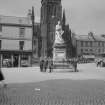Pricing Change
New pricing for orders of material from this site will come into place shortly. Charges for supply of digital images, digitisation on demand, prints and licensing will be altered.
Upcoming Maintenance
Please be advised that this website will undergo scheduled maintenance on the following dates:
Thursday, 9 January: 11:00 AM - 3:00 PM
Thursday, 23 January: 11:00 AM - 3:00 PM
Thursday, 30 January: 11:00 AM - 3:00 PM
During these times, some functionality such as image purchasing may be temporarily unavailable. We apologise for any inconvenience this may cause.
Dumfries, Church Place, Robert Burns Statue
Statue (19th Century)
Site Name Dumfries, Church Place, Robert Burns Statue
Classification Statue (19th Century)
Alternative Name(s) Burns Statue At Greyfriars' Church; High Street; Castle Street
Canmore ID 159251
Site Number NX97NE 217
NGR NX 97140 76250
Datum OSGB36 - NGR
Permalink http://canmore.org.uk/site/159251
- Council Dumfries And Galloway
- Parish Dumfries
- Former Region Dumfries And Galloway
- Former District Nithsdale
- Former County Dumfries-shire
NX97NE 217 97140 76250
The statue of Robert Burns stands in the centre of Dumfries and was commissioned by the town council of Dumfries in 1877. The model was created by sculptor Amelia Paton Hill and carved by Italian craftsmen in Carrara. It was unveiled in 1882. The figure of Robert Burns is portrayed in a seated position with a faithful dog at his feet. It was created in Carrara marble, with a sandstone plinth.
The statue was cleaned, repaired and restored in 2005. This involved repairing decayed areas affected by pollution, removing biological growth, cleaning and repairing water traps, removing 'pollution crust', which was upto 15mm thick. In addition, a number of cracks were treated and repaired, along with previous poor-quality repair work. Weathered areas of the statue were repaired. Finally, the sandstone plinth was repaired, cleaned and restored.
N Boyes 2005.








